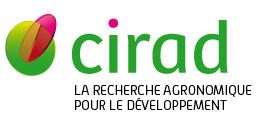Diversity and mosaic structure of ant (Hymenoptera: Formicidae) community in traditional cocoa agroforestry systems in southern Cameroon
Tadu Z., DjiÃĐto-Lordon C., Fomena A., Babin R., Mahiane G., YÃĐdÃĐ. 2009. In : Atelier PCP-REPARAC "Innover pour amÃĐliorer les revenus des exploitations familiales et la production agricoles du Grand Sud Cameroun, 24-26 juin 2009, Mbalmayo, Cameroun. s.l. : s.n., 1 p.. Atelier PCP-REPARAC "Innover pour amÃĐliorer les revenus des exploitations familiales et la production agricoles du Grand Sud Cameroun", 2009-06-24/2009-06-26, Mbalmayo (Cameroun).
In cocoa agrosforestry systems, ants are the major arthropod component of the canopy. Since dominant ant species are usually active predators of insects. Ant community may contribute to protect cocoa against insect pests, and especially from cocoa mirids. On the other hand, ant activities may be involved in disease epidemics, and then lead to significant crop losses. In Cameroon, little information is available on ant community in cocoa agroforests and on their contribution to cocoa health. Therefore, the main objective of this study was to characterize the ant mosaic in cocoa farms by assessing the diversity of ant species, the nature of ant associations and their ecological statute. For two consecutive years, we collected ants using a chemical knock-down sampling method, in 21 cocoa plantations, situated in three different agro ecological areas of the center region of Cameroon. The ant diversity was assessed using the species richness, Shannon`s index of diversity and the Sorensen`s similarity index. Kendall`s correlation coefficient was used to determine the association nature between ant species. The robustness of associations was appreciated using chi-square test with Yates corrected test. Fifty one ant species were collected the first year of experimentation and sixty five the second year. Ants of the subfamilies Formicinae and Myrmicinae were the most abundant and the most diverse in cocoa plantations. According to the Shannon`s index of diversity, ant community was less diversified in the plantations located in the savannah compared to those of the forest areas. Oecophylla longinoda, Crematogaster clariventris, Crematogaster striatula and Camponotus acvapimensis were the most abundant species for the first year, with 50.9%, 35.2%, 21.1% and 14.1% individual respectively. The second year, O. longinoda, Tetramorium aculeatum, the army ant Dorylus (Anoma) nigricans and C. striatula were the most abundant, with rates of 82.2%, 44.1%, 39.2% and 29.4% respectively
Mots-clÃĐs : formicidae; theobroma cacao; agroforesterie; cameroun; cameroun sud
Documents associÃĐs
Communication de congrÃĻs
Agents Cirad, auteurs de cette publication :
- Babin RÃĐgis — Bios / UMR PHIM
